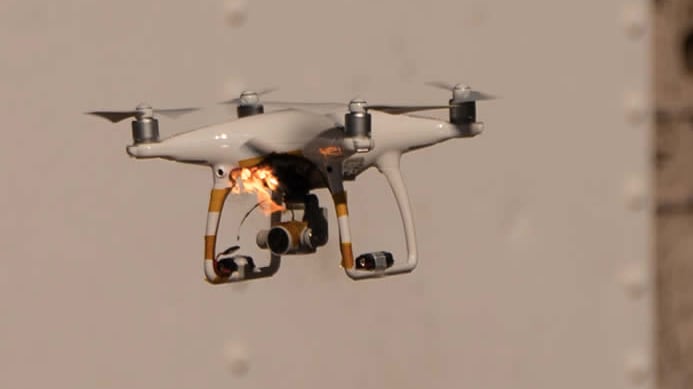In a windowless room on Raytheon’s campus in McKinney, Texas, a small team of blue jean-clad engineers and physicists is doing something that’s never been done before. They move back and forth between computer screens and a vehicle that looks like it’s straight out of Mad Max.
“Basically, we’re putting a laser on a dune buggy to knock drones out of the sky,” said Dr. Ben Allison, director of Raytheon’s high energy laser product line.
It’s actually a little more complicated than that, Allison added. The team is combining a high energy laser with an advanced variant of Raytheon’s Multi-spectral Targeting System – a sophisticated package of electro-optical and infrared sensors – and installing it on a Polaris MRZR, a small, all-terrain vehicle.
In an homage to Austin Powers, Art Morrish, vice president of Advanced Concepts and Technology at Raytheon Space and Airborne Systems, said, “It’s not sharks with laser beams on them, but it’s pretty close.”
A defense against drones
According to Allison, the idea grew out of a meeting with Raytheon’s CEO and Chairman Tom Kennedy earlier this year. Kennedy told Allison and Morrish that an allied nation had recently used a Patriot missile to shoot down a cheap, store-bought UAS that was outfitted with a grenade-like munition.

“That cost-to-kill ratio is high,” explained Allison, “but the threat is clear. So, the question became, ‘What can we do for a counter-UAS system using a high-energy laser, and do it quickly. We didn’t want to go out and do a bunch of research and development. We wanted to take the assets and capabilities Raytheon has today and use them to really affect this asymmetrical threat. We settled on a small system that’s hugely capable.”
Good Things Come in Small Packages
The team first looked at putting its laser on a standard-size military container, but soon realized it only took up a quarter of the available space. At the same time, an undisclosed customer was exploring ways to put a laser weapon system on vehicles small enough to fit in an airplane’s cargo bay or inside a helicopter.
“When we saw how small we could make it and we saw a clear customer need, we immediately wanted to find a very tactically relevant vehicle that could get out to forward operating bases and do its mission,” said Allison.
The system is standalone, with a footprint of roughly 30 square feet. On a single charge from a standard 220v outlet, the same kind you plug your washing machine into at home, the HEL system onboard the MRZR delivers four hours of intelligence, surveillance and reconnaissance capability and 20 to 30 laser shots. The system can also be coupled with a generator to provide virtually infinite magazine depth.
While the laser and the vehicle are sure to draw all the attention, it’s the weaponized MTS sensor package that is the core of the system. In this configuration, the MTS provides its standard setting ISR and tracking capabilities while also serving as a beam director.
That’s something Allison says sets this combo apart from bigger, more power-hungry systems. “If you have a good beam director, then you can use a smaller, more efficient laser. You can make your system smaller and more flexible,” said Allison.
Hitting the Road
Morrish believes the solution is particularly suited for expeditionary missions.
“Right now, it’s a shoot-on-the-halt capability,” said Morrish. “You drive the vehicle wherever you’re going to drive it. You stop and then you fire up the laser. That makes it great for protecting forward-operating bases and places where convoys have to stop. The next step is to set it up so you can actually shoot on the move.”
Raytheon began field testing the HELWS MRZR last week, and is slated to demonstrate it at the U.S. Army’s Maneuver Fires Experiment at Fort Sill, Oklahoma, in December.
“The idea is to quickly take this solution out of the lab and put it in the hands of the operators,” said Morrish. “The folks in uniform are going to find ways to use it that those of us in lab coats never have.”

